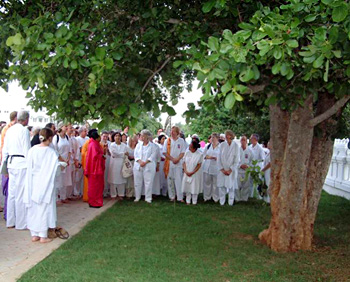 The whole life of a pious Jaina from his first to the-last breath is accompanied by holy actions. The individual ceremonies differ with different sects and regions in many respects; they are not even performed in the same manner at all the times. The first rites which are connected with the life of a man are performed before his birth.
The whole life of a pious Jaina from his first to the-last breath is accompanied by holy actions. The individual ceremonies differ with different sects and regions in many respects; they are not even performed in the same manner at all the times. The first rites which are connected with the life of a man are performed before his birth.
Before and after the birth of a child a lot of rituals are carried on for the well being of the child. Before the child is born rituals are carried on the father and mother in order to assure the well being of the child.
The most important event between birth and marriage is Upanayana. The Upanayana takes place only among the male members of the upper three castes; among Brahmanas, it is in the 8th year, among Kshatriyas in the 11th and among Vaisyas in the 12th year after Garbhaddhana. Sudras are not allowed this ceremony which finds its visible expression in the wearing of the holy thread.
The beginning of study (Adhyayana) is reckoned as the 13th sacrament. It is performed under certain formalities. The pupil takes his place on a seat of Kusa-grass on the left side of the Guru in a temple or under a Kadamba-tree. The Guru whispers the Sarasvata-Mantra thrice into his right ear. Then he is led in a solemn procession to an Upadhyaya, who then begins the lesson. He teaches to Brahmanas Ayurveda (medicine), then the 6 Arigas, the law books and the Puranas, to Kshatriyas medicine, archery, politics and the knowledge necessary for one`s sustenance (Ajrvika), to Vaishyas the law books and prudence and to the members of the other castes the knowledge that is proper for them.
The 14th sacrament, "marriage" (Vivaha) is the most significant for the society. This is allowed to be contracted only among persons who belong to the same caste, but to a different Gotra.
Human happiness becomes a receptacle of fortune and it bears fruits in this and the other world only then when the man succeeds in fulfilling the pious vows. These "Vratas" are reckoned as the 15th sacrament and considered as the most important of all.
The "last sacrament" (Antyasamskara) that is given to a pious Jaina is the cremation. When someone is in his death bed, his relatives give him spiritual consolation; his Guru is called to give him consolations, recite Mantras to him and make him recite them. When death approaches, a pious man vows not to take any solid or liquid diet and renounces all worldly desires. He makes donations to the religion, to its servants and to the poor and finally dies concentrating all his thoughts on the five Paramesthis.
The dead body is put down on the ground, washed, anointed with perfumes and new clothes are put on it then it is put on a bier and carried by four near relatives on the shoulders to the place of cremation. A pyre is kept ready there. It is placed on a stone to prevent the destruction of other living beings. The pyre is kindled with the fire that is brought from the house of the deceased. Once the corpse is reduced to ash, the mourners return home. Then the ash is thrown into a river by a near relative on the third day, while the mortal remains are buried near a consecrated place.
Thus it can be concluded saying that a common man in a Jain Community has to carry out a number of rites during the special ceremonies of life and it is essential that the rites of the ceremonies are carried out in a proper manner.




















